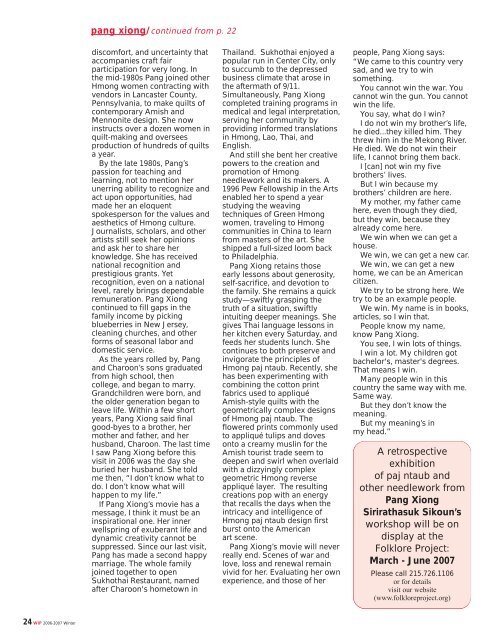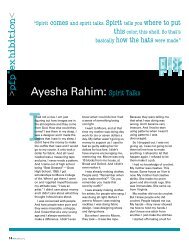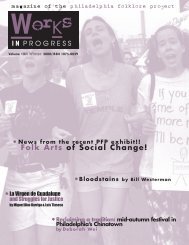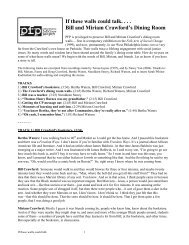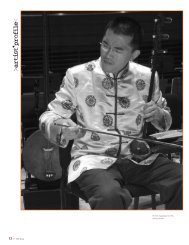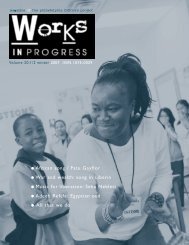View PDF - Philadelphia Folklore Project
View PDF - Philadelphia Folklore Project
View PDF - Philadelphia Folklore Project
- No tags were found...
You also want an ePaper? Increase the reach of your titles
YUMPU automatically turns print PDFs into web optimized ePapers that Google loves.
pang xiong/continued from p. 22discomfort, and uncertainty thataccompanies craft fairparticipation for very long. Inthe mid-1980s Pang joined otherHmong women contracting withvendors in Lancaster County,Pennsylvania, to make quilts ofcontemporary Amish andMennonite design. She nowinstructs over a dozen women inquilt-making and overseesproduction of hundreds of quiltsa year.By the late 1980s, Pang’spassion for teaching andlearning, not to mention herunerring ability to recognize andact upon opportunities, hadmade her an eloquentspokesperson for the values andaesthetics of Hmong culture.Journalists, scholars, and otherartists still seek her opinionsand ask her to share herknowledge. She has receivednational recognition andprestigious grants. Yetrecognition, even on a nationallevel, rarely brings dependableremuneration. Pang Xiongcontinued to fill gaps in thefamily income by pickingblueberries in New Jersey,cleaning churches, and otherforms of seasonal labor anddomestic service.As the years rolled by, Pangand Charoon’s sons graduatedfrom high school, thencollege, and began to marry.Grandchildren were born, andthe older generation began toleave life. Within a few shortyears, Pang Xiong said finalgood-byes to a brother, hermother and father, and herhusband, Charoon. The last timeI saw Pang Xiong before thisvisit in 2006 was the day sheburied her husband. She toldme then, “I don’t know what todo. I don’t know what willhappen to my life.”If Pang Xiong’s movie has amessage, I think it must be aninspirational one. Her innerwellspring of exuberant life anddynamic creativity cannot besuppressed. Since our last visit,Pang has made a second happymarriage. The whole familyjoined together to openSukhothai Restaurant, namedafter Charoon's hometown inThailand. Sukhothai enjoyed apopular run in Center City, onlyto succumb to the depressedbusiness climate that arose inthe aftermath of 9/11.Simultaneously, Pang Xiongcompleted training programs inmedical and legal interpretation,serving her community byproviding informed translationsin Hmong, Lao, Thai, andEnglish.And still she bent her creativepowers to the creation andpromotion of Hmongneedlework and its makers. A1996 Pew Fellowship in the Artsenabled her to spend a yearstudying the weavingtechniques of Green Hmongwomen, traveling to Hmongcommunities in China to learnfrom masters of the art. Sheshipped a full-sized loom backto <strong>Philadelphia</strong>.Pang Xiong retains thoseearly lessons about generosity,self-sacrifice, and devotion tothe family. She remains a quickstudy—swiftly grasping thetruth of a situation, swiftlyintuiting deeper meanings. Shegives Thai language lessons inher kitchen every Saturday, andfeeds her students lunch. Shecontinues to both preserve andinvigorate the principles ofHmong paj ntaub. Recently, shehas been experimenting withcombining the cotton printfabrics used to appliquéAmish-style quilts with thegeometrically complex designsof Hmong paj ntaub. Theflowered prints commonly usedto appliqué tulips and dovesonto a creamy muslin for theAmish tourist trade seem todeepen and swirl when overlaidwith a dizzyingly complexgeometric Hmong reverseappliqué layer. The resultingcreations pop with an energythat recalls the days when theintricacy and intelligence ofHmong paj ntaub design firstburst onto the Americanart scene.Pang Xiong’s movie will neverreally end. Scenes of war andlove, loss and renewal remainvivid for her. Evaluating her ownexperience, and those of herpeople, Pang Xiong says:“We came to this country verysad, and we try to winsomething.You cannot win the war. Youcannot win the gun. You cannotwin the life.You say, what do I win?I do not win my brother’s life,he died...they killed him. Theythrew him in the Mekong River.He died. We do not win theirlife, I cannot bring them back.I [can] not win my fivebrothers’ lives.But I win because mybrothers’ children are here.My mother, my father camehere, even though they died,but they win, because theyalready come here.We win when we can get ahouse.We win, we can get a new car.We win, we can get a newhome, we can be an Americancitizen.We try to be strong here. Wetry to be an example people.We win. My name is in books,articles, so I win that.People know my name,know Pang Xiong.You see, I win lots of things.I win a lot. My children gotbachelor's, master's degrees.That means I win.Many people win in thiscountry the same way with me.Same way.But they don’t know themeaning.But my meaning’s inmy head.”A retrospectiveexhibitionof paj ntaub andother needlework fromPang XiongSirirathasuk Sikoun’sworkshop will be ondisplay at the<strong>Folklore</strong> <strong>Project</strong>:March - June 2007Please call 215.726.1106or for detailsvisit our website(www.folkloreproject.org)24 WIP 2006-2007 Winter


